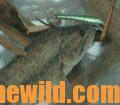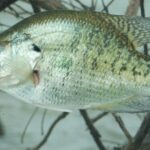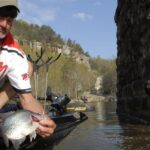Editor’s Note: Greg Hackney, 47 years old of Gonzales, Louisiana, has fished his entire life and fished professionally for 19 years. On www.bassfan.com Hackney is ranked No. 28 in the world and also has been B.A.S.S. Angler of the Year, the FLW Angler of the Year and the Major League Fishing (MLF) World Champion. (https://www.facebook.com/pg/greghackneyfishing/about/?ref=page_internal)
You can’t beat a suspending jerkbait, for January bass fishing because this lure has a dying effect built into it. Once you get the lure down, you give it a jerk and stop it, and it will sit there like a baitfish that’s about to die. Then it gains energy, and after awhile, moves a little bit further in the water. January and February are generally the coldest water of the year, and the bass will be slow moving. The entire country will have shad die-offs these months. The water temperature will get down into the high 30s or low 40s, even in the South. When the 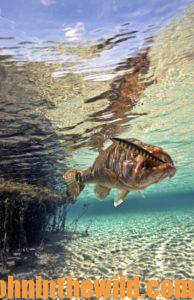 shad die-off, it makes them easy prey for the bass. The water’s so cold that the bass really don’t want to chase a bait. So, after you jerk the bait, and that bait sits still, the bass assumes that the suspending jerkbait is about to die. The fish will ease up to the lure and suck it in its mouth.
shad die-off, it makes them easy prey for the bass. The water’s so cold that the bass really don’t want to chase a bait. So, after you jerk the bait, and that bait sits still, the bass assumes that the suspending jerkbait is about to die. The fish will ease up to the lure and suck it in its mouth.
The best way to fish the suspending jerkbait at this time of the year is to deadstick it (like you do a plastic worm). Once I get the jerkbait down to the depth I want to fish it and twitch it one time, I’ll let the bait sit still for a count of 20 seconds. You know how to count seconds, 1 Mississippi, 2 Mississippi…etc. After you get the first bite, then you’ll know how many seconds you need to let the bait sit still before you move it. For instance, if I get a bite when I hit 9 Mississippi, then I know that’s about the length of time a bass wants the bait to sit still before it eats the lure. If I have a bait sit still until I count 14 Mississippi and don’t get a bite, I need to go ahead and move the lure. Next I’ll let it sit until I count 12 Mississippi or longer. Some days the bass will hit the lure on 2 Mississippi. The next day bass may not take jerkbaits until you reach a count of 20 Mississippi. Some days you get the lure down, stop it and barely move it with the slack in your line before the winter bass will take the bait. Once you get the jerkbait down, you have to experiment with how long the fish want the bait to sit still and how much movement they want to see in the bait.
When the water gets very cold, the bass have a tendency to suspend, because the warm water is often near the surface, as well as close to the bottom. Remember that cold water sinks, and warm water rises. Therefore, often the warmest water, even on the coldest days, will be near the surface, especially if the sun’s shining. Sometimes the water temperature will be the same from the top of the water column to the bottom of the water column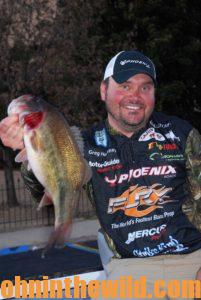 . That being true, the bass can hold in any water depth. A suspended jerkbait is easy for the bass to catch, looks natural at that time of the year and has the same action as the dying shad the bass are accustomed to eating.
. That being true, the bass can hold in any water depth. A suspended jerkbait is easy for the bass to catch, looks natural at that time of the year and has the same action as the dying shad the bass are accustomed to eating.
Once you decide at what depth the fish are holding in, that’s the depth where you want your jerkbait to suspend. By varying your line size, you can get the jerkbait to suspend at various depths. If I want my suspending jerkbait to suspend higher in the water column, I’ll use bigger line than I will if I want it to suspend deeper in the water. I don’t use fluorocarbon line at this time of the year because it sinks, and the jerkbait is a neutral-buoyancy lure. If you use fluorocarbon line, it will cause the bait to sink rather than to suspend. That’s why I prefer monofilament line when I’m fishing a suspending jerkbait. You also may want to change hooks, and use a heavier hook to sink a jerkbait deeper. If you want the jerkbait to suspend nose-down, add an additional split ring to the nose of the lure. Sometimes when I’m fishing for smallmouths, I’ve noticed that the smallmouths prefer jerkbaits to sit in the water nose-down in January and February. So, I may put heavier hooks on the front of bait than I have on the back of the bait to make the lure sit in the water with its nose pointed down.
Usually I like a natural shad color suspending jerkbait. If the water has a little color to it, chrome with a black back is hard to beat. On a real sunny day, with a little bit of wind, that chrome with a black back will get the bass’s attention. The clearer the water is, the more natural I want the bait to look. Most of the time, I’ll be fishing a jerkbait on 12-pound-test monofilament line.
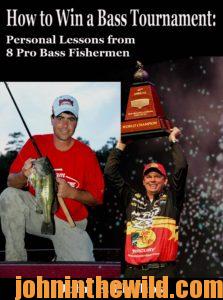 To learn more about catching bass, check out John E. Phillips’ book, “How to Win a Bass Tournament: Personal Lessons from 8 Pro Bass Fishermen,” at http://amzn.to/Wkbyxk and available in Kindle and print versions.
To learn more about catching bass, check out John E. Phillips’ book, “How to Win a Bass Tournament: Personal Lessons from 8 Pro Bass Fishermen,” at http://amzn.to/Wkbyxk and available in Kindle and print versions.
Tomorrow: Angling Jerkbaits for Winter Bass with Roger Stegall and Kevin VanDam


